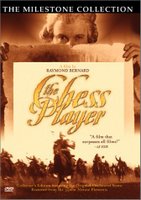10/09/06 The Chess Player
 The Chess Player (1927), directed by Raymond Bernard
The Chess Player (1927), directed by Raymond BernardWatched w/ Leslie; DVD rental (Netflix) @ home
In what seems a very grandiose scheme for an epic silent film, this classic French-made film follows the embroiled history of the 18th century Polish revolution against Russian occupation, all boiled down to one momentous chess player and his strategy. Boleslas is the rebel leader of the Polish troops who have been trying to reclaim their land from their Russian captors, and becomes a soldier that is challenged to escape his way out of the battles that he has been up against and try to win the woman he loves. The wacky Baron Von Kempelen is the mad scientist who likes nothing more than to sit around his mansion concocting creepy and humanlike automatons that will one day rule the world and fight man’s battles for them. When the Baron challenges the great Russian Empress Catherine II to a game of chess to determine his creations’ skills, the lady is none too impressed with the automatons’ actions. What she doesn’t know is that the Baron has smuggled the rebel Boleslas into the machine’s body and had him playing as the robot itself! Yeah, it’s that strange...but since it’s a silent film, the overwhelming classical soundtrack and epic battle scenes carry most of the leading characters through the turmoil that is ensuing all around them, whilst in the middle of a mind game to the death. The cinematography and kinetic frenzy of the film itself call to mind the grim realities that this story is based in, but also just how experimental and new the cinematic form was at the time. This much referenced classic (one interesting example is the 2003 documentary “Game Over: Kasparov And The Machine” which owes its depiction of the chess master’s challenge of taking on IBM’s computer Deep Blue in a strategic mind game of chess) is not only a cultural landmark in film with its storyline, but also heavily influenced a lot of today’s dark tones in conveying mood with cinematic flare (imagine if you will, Nine Inch Nails’ modern macabre classic music video for the song “Closer” with tortured monkeys and deviant sex acts galore). Also, aside from the overtly sinister feelings you get with watching the movie (the automatons would seem to me the very same creepy talking robots you see in today’s museums recounting historic trivia to schoolchildren on field trips)…I can’t shake the image of that magical vending machine game that the teenage boy plays at the carnival in the movie “Big” so he can turn into an adult Tom Hanks and land a mega-millionaire movie star billing. That would be pretty sweet.
4 out of 5 stars

0 Comments:
Post a Comment
<< Home